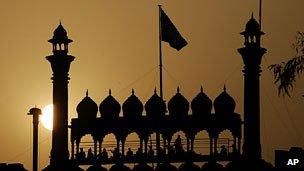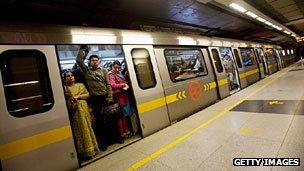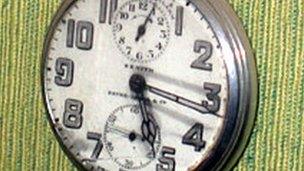Five things you didn't know about Delhi
- Published
As Delhi celebrates 100 years as a capital, author Sam Miller supplies a few snippets of fact and trivia about the city that may have escaped you.
PROBABLY ONCE THE MOST POPULOUS CITY
In the 1670s, under the rule of the Mughal Emperor Aurangzeb, Delhi briefly overtook Constantinople (now known as Istanbul) as the world's largest conurbation - according to the venerable urban statistician Tertius Chandler.

Delhi flourished during Mughal rule
Delhi, by this time, was already full of the ruins of past empires still visible on the streets of the modern city.
The sudden new growth in population was caused by Aurangzeb's father, Shah Jahan, who built a new capital just north of the ruins. The new city was named Shahjahanabad after him - and is now known as Old Delhi.
Delhi began to shrink again as the Mughal Empire gradually disintegrated, and Constantinople was restored to its position as the most populous city in the world.
According to 2011 estimates by Demographia, external, Delhi is now the second largest urban area in the world, behind Tokyo, while Istanbul trails far behind in 19th position.
THE WORLD'S FASTEST GROWING URBAN RAILWAY SYSTEM
At the start of the new millennium, Delhi's Metro railway did not exist. The first line connecting just six stations opened to the public on 25 December 2002.

The Delhi network has 146 stations
The network now has 146 stations, and is due to grow over the next decade to more than 220 by 2015, and, tentatively, to overtake the London's underground's 270 stations before 2020.
But Delhi is not the country's first Metro.
Calcutta's Metro opened in 1984 but has grown very slowly, with just 23 stations by the end of 2011.
India's third Metro, in Bangalore, opened in October 2011 and currently has seven stations.
THE MYSTERY OF GANDHI'S TWO WATCHES
Mohandas Gandhi, India's most important independence leader, was shot dead by a Hindu fanatic in the garden of Birla House, in what is now central Delhi, on 30 January 1948.

The 17 minutes past version
The museum dedicated to his life at Birla House has as one of its exhibits the watch that Gandhi was wearing when he was killed - and which stopped at his time of death - 17 minutes past five.
Strangely, the city's other Gandhi museum, close to the site of his cremation on Rajghat, also has a watch that he was said to be wearing when he died, though the hands on this one point to 12 minutes past five.
I have not been able to find out which is the real watch.
AT LEAST EIGHT DELHIS IN THE US
The American states of California, Colorado, Iowa, Louisiana, Michigan, Minnesota, New York and Ohio all have settlements called Delhi.
Most of them are named after the Indian capital. However, Delhi, California with a population of 10,755 - is actually pronounced Dell-high and was so named because it is close to the Delta-Highline Canal.
The state of Wisconsin has a ghost town called Delhi on the Fox River. Once an important trading post, well-known for its high-quality maple syrup, it has now disappeared - apart from one old house, and a lane that marks where the main street once was.
BIRTHPLACE OF AT LEAST FOUR WESTERN POP ARTISTS
Brothers Peter Sarstedt (Where Do You Go To, My Lovely), and Eden Kane (Well I Ask You; Boys Cry) were born in Delhi in the 1940s before Indian independence - and both of them had Number One hits in the 1960s.
Eden Kane, under his real name Richard Sarstedt, would go on to play a number of minor roles in the long running science fiction TV series Star Trek. A third brother, Robin Sarstedt, had a hit with My Resistance Is Low in 1976, but he was born in Ajmer, not Delhi.
The Canadian singer, Bif Naked, originally known as Beth Torrent, responsible for the controversial **** You Too, and Lucky, external, was born in India in 1971 and adopted by American missionaries.
Fellow Canadian singer-songwriter Emily Haines, lead vocalist and keyboard player with the band, Metric (Help I'm Alive, Gimme Sympathy ) was born in 1974 in Delhi, where her parents were living at the time.
Sam Miller is the author of Delhi: Adventures in a Megacity, and The Blue Guide to India.